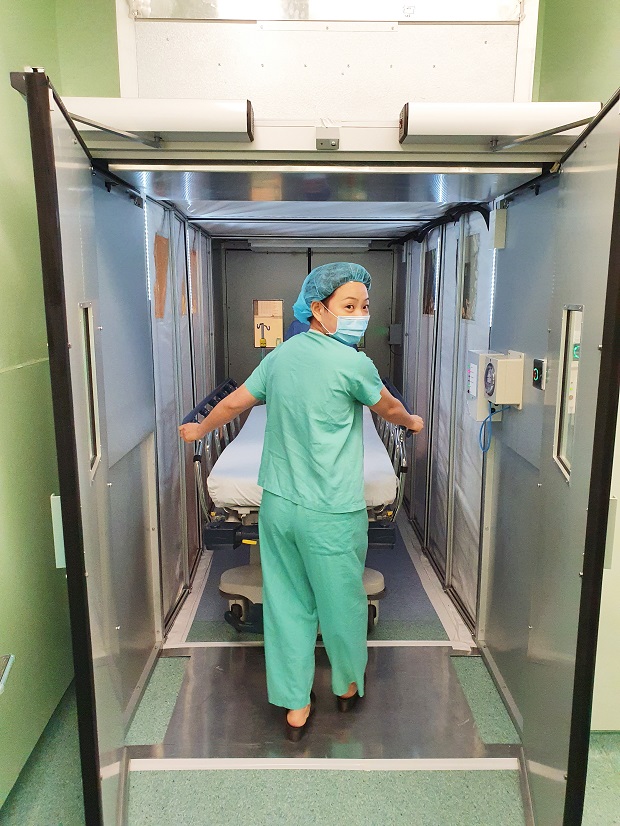A newly developed portable system is able to quickly convert wards and ICUs into negative-pressure isolation rooms to meet real-time crunch during an infectious disease ourbreak.
When a pandemic strikes, special isolation rooms known as negativepressure isolation rooms play an essential role in protecting hospital staff and patients.
A common infection control feature in hospitals, they work by creating a one-way flow of air so that airborne pathogens do not flow out of the room and into the ward corridors to infect others nearby.
But when there is rapid rise in the number of infectious patients admitted to hospital, increasing temporary isolation facilities or single rooms may be needed to care for them. However, converting or building facilities takes time and can be costly.

<<Converting a room involves a simple process of fitting the rectangular transparent box-like structure at the entrance or a doorway by sealing any gaps in between. The operating room version takes two hours to install, and is large enough to fit healthcare workers, a standard ICU bed and various medical equipment, such as an ICU ventilator.>>
To cope with a sudden surge during a pandemic, a team of anaesthesiologists from Singapore General Hospital (SGH) worked with local biomedical incubator, The Biofactory, to come up with a portable and collapsible negativepressure anteroom system that can be set up in less than an hour.
Named the System of Portable AnteRoom for Containment (SG-SPARC), the project was funded by SingHealth Duke-NUS’ Urgent COVID-19 Research Fund, with in-kind contribution from The Biofactory.
Hospital staff can quickly convert existing patient rooms into negative-pressure anterooms using a single power point, without major renovation.
“Seeing how hospitals overseas struggled when they ran out of negative-pressure rooms got us thinking if there is a way for us to swiftly and temporarily convert existing patient rooms, especially intensive care unit (ICU) rooms, to care for infectious patients when the need arises,” said Dr Mavis Teo, Consultant, Department of Anaesthesiology, SGH, who is the project’s co-investigator.
“With SG-SPARC, we not only save costs from avoiding the need to build any permanent structure, but also protect our healthcare workers from possible infection risk as the ward corridor is kept clean.”
SGH has 35 single isolation and 16 shared isolation rooms in Ward 68, and 50 negative-pressure isolation units at Ward@Bowyer.
With the SG-SPARC system in place, Dr Teo said it is possible to transform whole wards into isolation rooms within an hour. “As long as there is a pre-existing door, we will be able to fit SG-SPARC onto it and convert the ward immediately,” she added.
Weighing 70kg, each SGSPARC unit measures 1.2m in length, 1.55m in width, and 2.4m in height. The team has also developed a larger model for operating theatres (OT), which have wider doors — each of this weighs 150kg, and measures 3.78m in length, 1.6m in width, and 2m in height.
This will allow surgeries that involve aerosol-generating procedures to be performed on patients with suspected or confirmed infectious diseases in the OT, while protecting healthcare workers outside the room, Dr Teo said.
SG-SPARC marks The Biofactory’s third collaboration with SGH. The other two projects were SG SAFE, a foldable swab screen system; and SG SAFE.R, an isolation X-ray booth, which are currently in use at SGH.
According to Mr Gabriel Tan, Programme Director, The Biofactory, some local and overseas buyers have indicated an interest in SG-SPARC, and there are plans to commercialise the technology to meet global demand.
